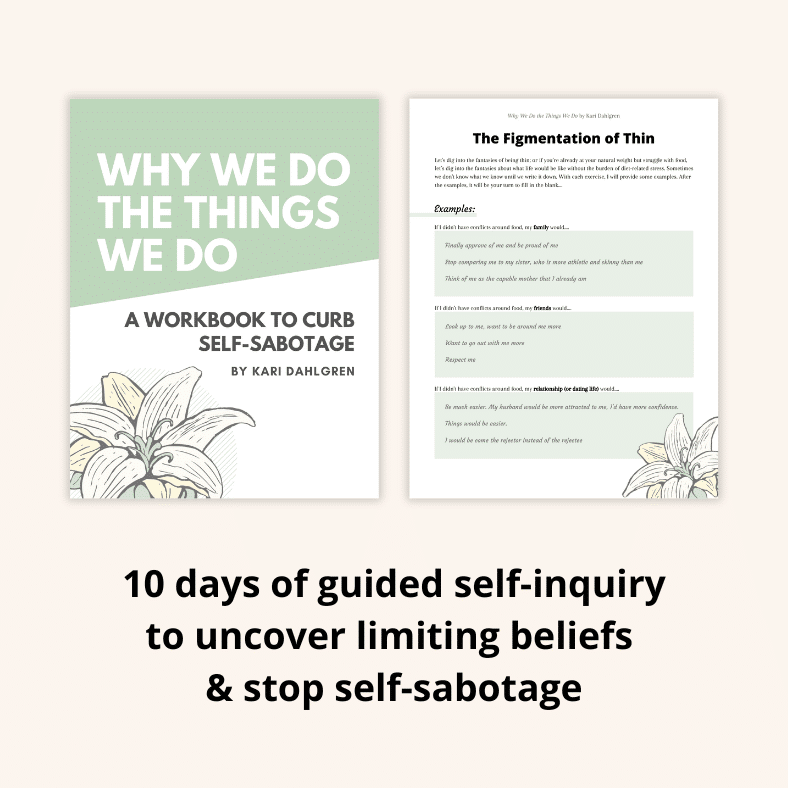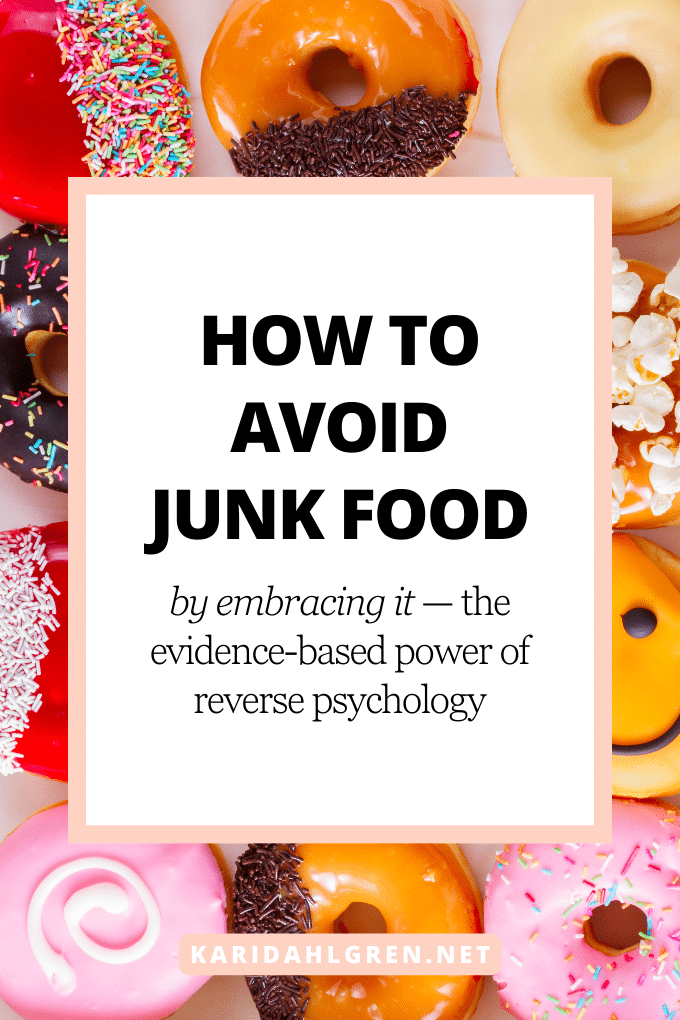
Do you ever feel like you tend to eat the most junk food after a spell of eating well? Make no mistake — it is not a coincidence. Research shows that the more we try to resist junk food, the more we crave it.
Back when I was still battling with yo-yo dieting, I would constantly struggle with cravings for crunchy, salty chips while at my desk. The allure of junk food was distracting, and I felt like I was using all my willpower to resist it — only to later end up eating a few “fun size” bags in one go.
Ultimately, it was in embracing junk food that I finally got to a place where I eat much less of it than before. Eating psychology is powerful, and reverse psychology is effective, as you’ll soon see.
In this guide, you’ll discover how junk food is engineered to be tempting, and why we should stop calling it “junk food” altogether. Then, I’ll share some evidence-based tips for learning how to find a healthy balance with junk food — where low-nutrient treats are not the enemy and instead an instrument towards a healthy, relaxed relationship with food.
Understanding the Appeal of Junk Food
Junk foods are often hyperpalatable, which refers to a carefully engineered combination of fat, carbs, sugar, and/or salt that excite the taste buds and make us want more. Think: salty/fatty chips or sweet/salty chocolate pretzels. If you’re trying to learn how to avoid junk food, you’re probably quite familiar with the irresistible allure of hyperpalatable food, which is rooted in biology and psychology.
Biologically, hyperpalatable “junk food” ingredients not only enhance flavor but also trigger a release of dopamine, a neurotransmitter associated with pleasure and satisfaction.[1] When junk food consumption goes beyond the use of food as fuel, it becomes hedonic eating, where the primary motivation is the sensory joy derived from eating, rather than nutritional need.[2]
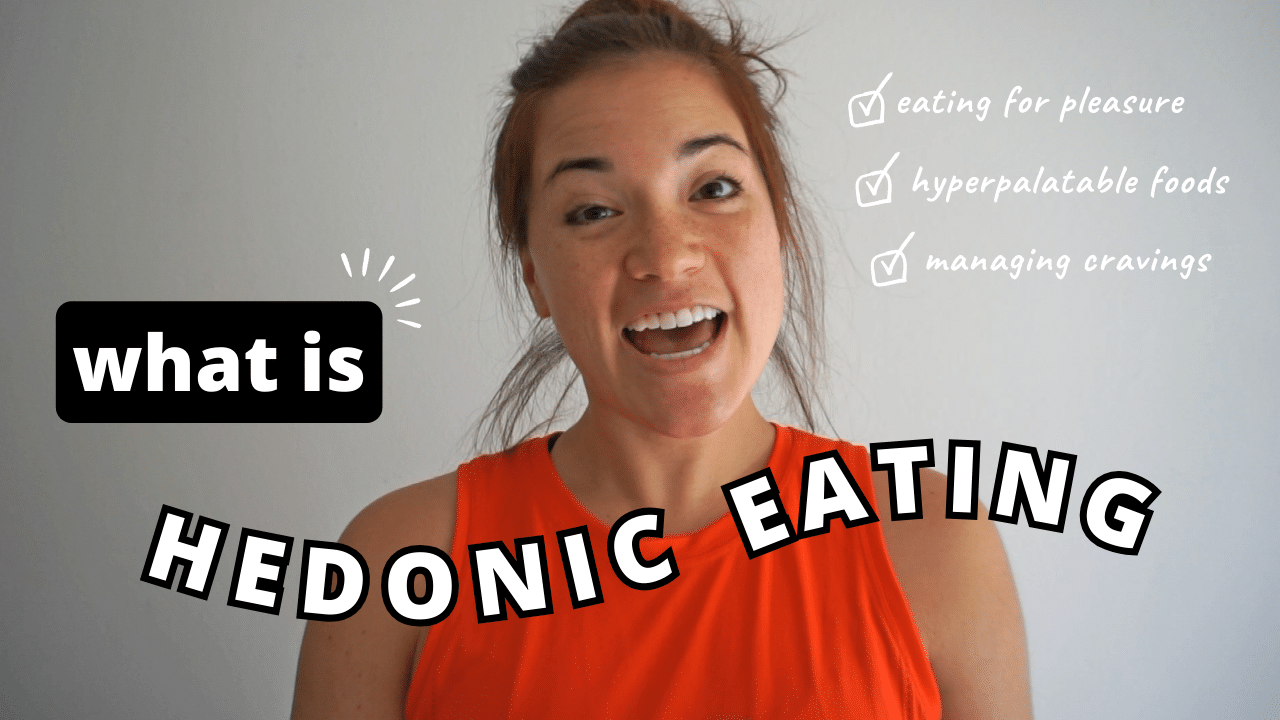
When junk food is consumed, this dopamine release activates the brain’s reward circuits, similar to the way some drugs can — underpinning the controversial phenomenon of food addiction.[3] This triggers the “pleasure trap,” a cycle of intense cravings and repetitive eating, driven by the potent lure of immediate gratification.
Moreover, the psychological draw of junk food is amplified by societal factors. Advertising, using complex emotional appeals, often positions junk food as central to joyous, relaxing, or social moments. Cultural norms further endorse these foods during celebrations or as comfort, establishing an environment where indulgence is not only common but also encouraged.
For instance, a study published in Social Influence found that people are more likely to indulge in high-calorie foods if it means evoking positive emotions in others.[4] This shows how junk food serves as a coping mechanism not only for personal emotional discomfort but also as a maladaptive strategy for “people pleasers.” (Yep, that was me too!)
The Problem with Calling It “Junk Food”
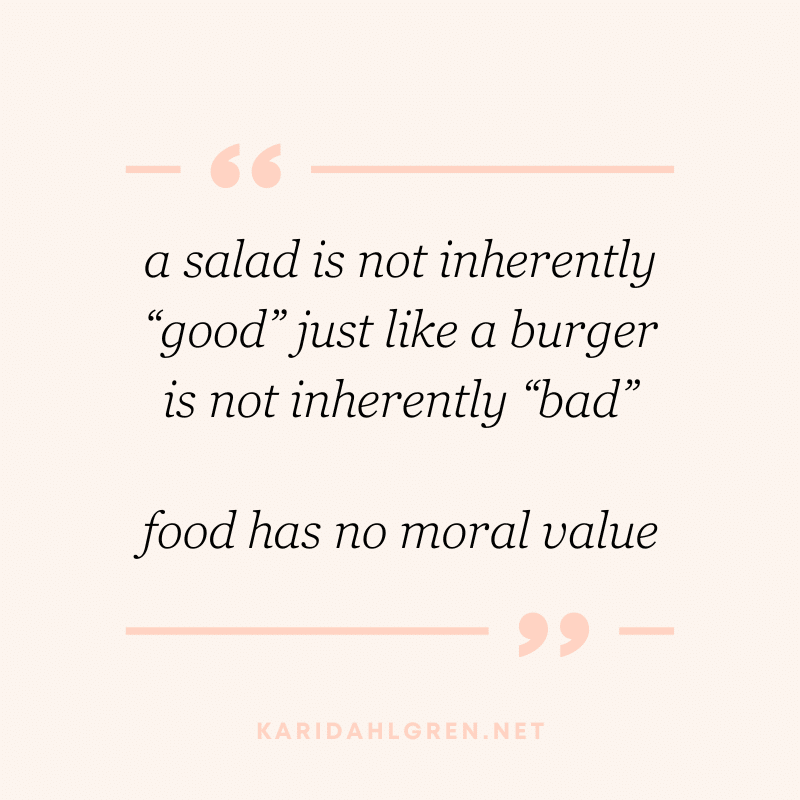
Before we delve into some tips for learning how to avoid junk food, it’s crucial to dissect that very terminology: “junk food.” Labeling foods as “junk” can inadvertently lead us down a problematic path, as the moralization of food (i.e. labelling foods as ‘good’ and ‘bad’) often results in negative psychological consequences such as guilt and shame after eating.
When left unchecked, feeling bad about the foods you eat can lead to an unhealthy relationship with eating, where maladaptive coping mechanism such as emotional eating become more prevalent. Meaning, if a 10-piece chicken nugget is simply what you’re craving out of true physical hunger, but you deny it or feel bad about eating it, you’re inflicting unnecessary damage.
Instead of viewing “junk food” as “bad,” try to shift your perspective to something more neutral like “low-nutrient food.” This is factually correct without inflicting as much guilt. As you begin to peel back the layers of diet culture, maybe you don’t refer to it as “low-nutrient food” anymore. Maybe it just becomes food.
Some people might wonder, “How can this be healthy? Junk food is not real food, and it should be called what it is: junk.” The argument is that junk food is typically void of micronutrients (vitamins and minerals). However, viewing all foods neutrally has its own benefits.
Research supports that up to one-fifth of your diet can consist of low-nutrient foods while still maintaining optimal nutrition.[5] All foods, including “junk food,” really can fit into a balanced diet.
This inclusive and practical approach helps dismantle the notion of ‘good’ and ‘bad’ foods, promoting a more positive and relaxed relationship with eating — all of which builds upon the following evidence-based eating psychology principles.
Applying Eating Psychology: How to Avoid “Junk Food” by Removing the Food Rules Altogether
Eating psychology reveals a paradox: the more we try to avoid “junk food,” the more appealing it becomes.
Research supports this, showing that selectively avoiding foods like chocolate can actually increase cravings, particularly among those who already have a high predisposition for these cravings.[6] This increase occurs despite maintaining a usual diet, emphasizing how psychological, not just physical, factors drive our eating behaviors.
Further studies highlight that perceived food deprivation often doesn’t match actual food intake but is closely linked to psychological feelings of restriction and a heightened focus on food.[7] This suggests that feelings of deprivation are more about our mindset than our physical consumption.
This brings us to the strategy of reverse psychology. By allowing all foods, including those often labeled as “junk,” we can decrease their forbidden allure and make healthier choices feel less enforced. This approach doesn’t lead to chaos but to a balanced diet where occasional indulgences are neither demonized nor overemphasized.
Many might worry that this freedom could lead to overeating or weight gain. Here, the keys are courage and compassion —embracing intuitive eating in a way that feels challenging but not overwhelming.

Letting go of strict dietary restrictions offers a way to eat that is driven by internal cues of hunger and satisfaction, rather than external pressures. This not only simplifies making food choices but also enhances our overall well-being, making eating a source of joy rather than stress.
More Evidence-Based Tips for Reducing Junk Food Consumption
As we unravel the complex psychological dynamics behind our eating habits, we see that managing our food choices involves more than sheer willpower. By adopting a holistic approach that welcomes all foods, we can foster a healthier relationship with eating. Now, let’s explore practical, evidence-based strategies that support a balanced diet and a positive eating environment.
Here are some actionable tips to help you make peace with “junk food” and find a balanced, relaxed relationship with food:
1. Practice Responsible Indulgence
One way to heal your relationship with food and reduce your intake of so-called “junk food” is to practice intuitive eating: eat when you’re hungry, enjoy the foods that appeal to you, and stop when you’re full.
If you’re worried that food addiction has altered your cravings and that you’ll only ever eat junk food and never stop, work on rebuilding trust in your body. Persistent cravings for junk food are often a result of restrained eating (e.g. dieting, avoiding “junk food”).[8] Once you heal your relationship with food, you may very well find that your body naturally craves a healthy variety of foods.
2. Let Go of the Food Rules
Again, plenty of research shows that restrained eating is associated with overeating, and reducing dietary restraint actually reduced binge eating.[9] Ultimately, it is a waste of willpower to resist the foods that would ultimately provide a sense of satisfaction and allow you to move on with your day.
Satisfaction is an important element of eating. Without it, you may continue to graze and snack in search of something that “hits the spot” — sometimes resulting in more food consumed than if you had just started with the “junk food” you craved to begin with.
3. Enjoy Your Food When You Do Indulge

Current research shows that enjoyment of food leads to healthy eating habits.[10] To find balance and prevent the restriction of certain foods from intensifying cravings for “junk food,” give yourself permission to eat the foods that you enjoy. This approach can decrease the allure of “forbidden” foods and promote a more balanced diet.
4. Enhance Emotion-Regulation Skills to Reduce Cravings for “Junk Food”
If you struggle with stopping at fullness, developing skills in emotion regulation can help. When someone has a low tolerance for distress, it makes it more difficult to stop eating pleasurable foods because they offer an emotional buffer. Enhanced distress tolerance is linked to reduced instances of overeating.[11]
To improve distress tolerance, practice my Stop, Drop, & Feel method. This involves pausing (Stop) when you want to eat beyond fullness, grounding yourself in the present moment (Drop), and embracing the full spectrum of your emotions (Feel) before deciding to eat. When you practice holding space for discomfort, your tolerance for discomfort increases.
5. Eat Slowly & Mindfully
It is well-documented that hyperpalatable foods are associated with increased energy intake.[12] When foods are engineered to be irresistible, it’s harder to stop at fullness. Practicing mindful eating and reducing eating speed encourages you to be fully present during meals, helping you recognize when you are full.[13] For some people like myself, mindful eating works best when combined with emotional eating tools like the Stop, Drop, & Feel.
6. Manage and Reduce Stress
Stress is a well-documented trigger for hyperpalatable food cravings.[14] Start paying attention to your stress levels and cravings for so-called “junk food” to identify any potential patterns. If a pattern emerges, incorporate stress-reduction techniques into your day such as taking breaks, deep breathing (underrated and highly effective!), and “movement snacks.”
For some people, intense occupational stress might be unmanageable due to company expectations or a demanding job description. If you find yourself sacrificing your health for your work, take some time to seriously reflect on the costs and benefits of your work. I’ve witnessed coaching clients move away from high-stress jobs, even at the expense of lower pay, in order to reduce stress and improve their overall quality of life — including their relationship with food.
How to Avoid Junk Food: The Reverse Psychology of Giving Up Dieting
Letting go of the food rules doesn’t mean eating exclusively “junk food” and never being able to stop. It’s about removing restriction so that enjoyment and moderation can finally and naturally emerge. Trying to strictly avoid “junk food” can actually heighten cravings and foster a cycle of yo-yo dieting. By effectively employing reverse psychology, we not only reduce the allure of low-nutrient, hyperpalatable foods but also enhance our overall well-being.
Let’s shift our focus from mere avoidance to rediscovering the joy of eating — appreciating flavors, and nourishing both body and mind. The journey to healthier living isn’t about excluding “junk food” entirely, but learning to enjoy all foods in a way that maintains balance and honors our biological and psychological needs. Here’s to a fulfilling relationship with food, where each meal brings pleasure and health in equal measure.
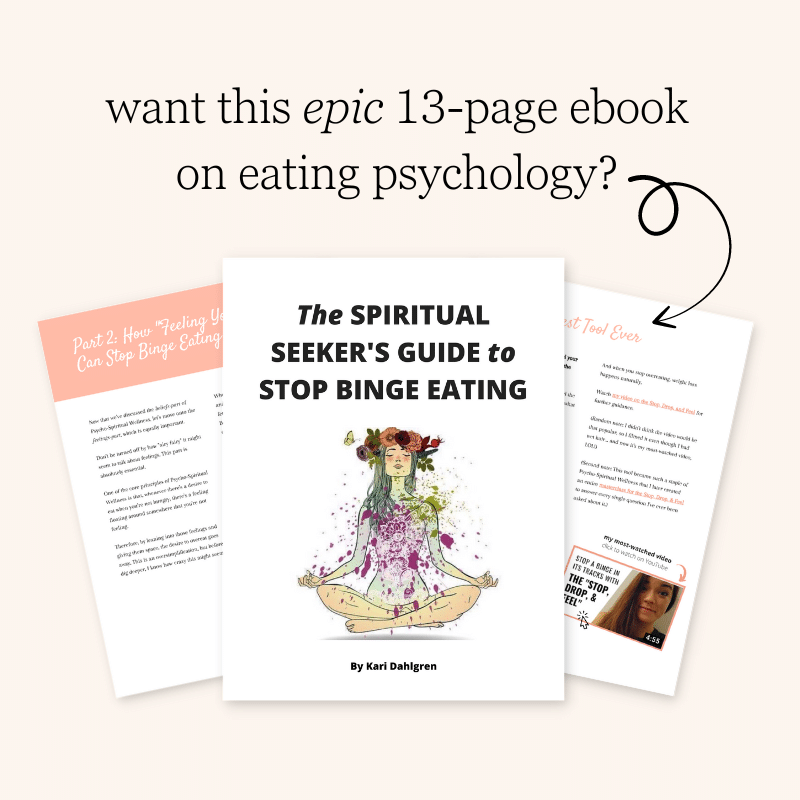
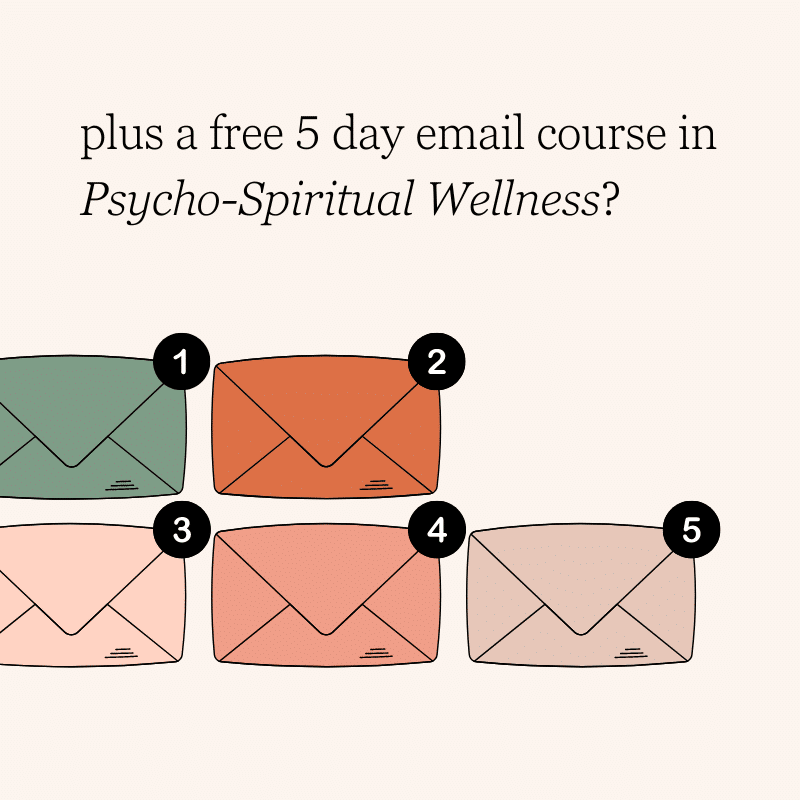
![best seller [cover of Why We Do the Things We Do]](https://karidahlgren-net.b-cdn.net/wp-content/uploads/2023/09/why-we-do-the-things-we-do-1.png)
